
NGC 52 is an edge-on spiral galaxy in the constellation Pegasus. It was discovered on September 18, 1784, by William Herschel. He described it as "very faint, small, extended."

NGC 67 is an elliptical galaxy located in the constellation Andromeda that was discovered on October 7, 1855, by R. J. Mitchell, who described it as "extremely faint, very small, round". The galaxy belongs to the NGC 68 group, which also contains the galaxies NGC 68, NGC 69, NGC 70, NGC 71, NGC 72, and possibly NGC 74.
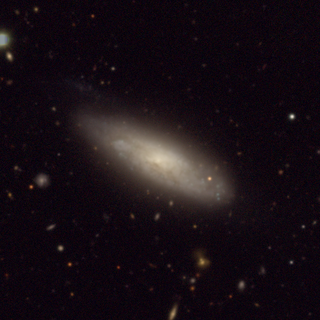
NGC 131 is a spiral galaxy that was discovered on September 25, 1834, by John Herschel. This galaxy belongs in the NGC 134 group of galaxies: NGC 115, NGC 148, NGC 150, PGC 2000, IC 1555, and PGC 2044.

NGC 174 is a barred spiral or lenticular galaxy around 159 million light-years away in the constellation Sculptor. It was discovered on 27 September 1834 by astronomer John Herschel.
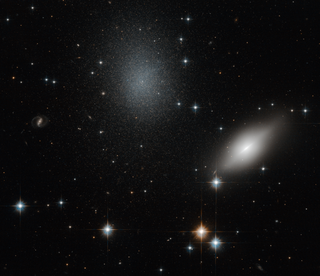
NGC 5011 is an elliptical galaxy in the constellation of Centaurus. It was discovered on 3 June 1834 by John Herschel. It was described as "pretty bright, considerably small, round, among 4 stars" by John Louis Emil Dreyer, the compiler of the New General Catalogue.
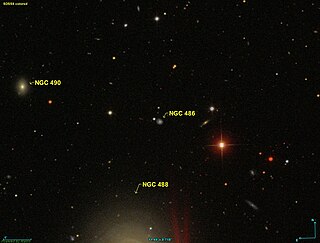
NGC 486, also occasionally referred to as LEDA 1281966 or GC 275, is a spiral galaxy in the constellation Pisces. NGC 486 was discovered on December 6, 1850 by Irish engineer Bindon Blood Stoney.

NGC 490, also occasionally referred to as PGC 4973 or GC 277, is a lenticular galaxy in the constellation Pisces. It is located approximately 85 million light-years from Earth and was discovered on December 6, 1850, by Irish engineer Bindon Blood Stoney. Although John Dreyer, creator of the New General Catalogue, credits the discovery to astronomer William Parsons, he notes that many of his claimed discoveries were made by one of his assistants. In the case of NGC 490, the discovery was made by Bindon Stoney, who discovered it along with NGC 486, NGC 492 and NGC 500 during his observation of NGC 488.

NGC 502, also occasionally referred to as PGC 5034 or UGC 922, is a lenticular galaxy in the constellation Pisces. It is located approximately 113 million light-years from the Solar System and was discovered on 25 September 1862 by German astronomer Heinrich Louis d'Arrest. When the Morphological Catalogue of Galaxies was published between 1962 and 1974, the identifications of NGC 502 and NGC 505 were reversed. In reality, NGC 502 is equal to MGC +01-04-041 and not MCG +01-04-043 as noted in the catalogue.

NGC 503, also occasionally referred to as PGC 5086 or GC 5169, is an elliptical galaxy in the constellation Pisces. It is located approximately 265 million light-years from the Solar System and was discovered on 13 August 1863 by German astronomer Heinrich Louis d'Arrest.

NGC 504, also occasionally referred to as PGC 5084 or UGC 935, is a lenticular galaxy located approximately 189 million light-years from the Solar System in the constellation Pisces. It was discovered on 22 November 1827 by astronomer John Herschel. The object was listed twice in the General Catalogue, precursor of the New General Catalogue, as both GC 291 and GC 292.

NGC 511, also occasionally referred to as PGC 5103 or UGC 936, is an elliptical galaxy in the constellation Pisces. It is located approximately 499 million light-years from the Solar System and was discovered on 26 October 1876 by French astronomer Édouard Stephan.

NGC 515, also occasionally referred to as PGC 5201 or UGC 956, is a lenticular galaxy located approximately 228 million light-years from the Solar System in the constellation Pisces. It was discovered on 13 September 1784 by astronomer William Herschel.

NGC 6040 is a spiral galaxy located about 550 million light-years away in the constellation Hercules. NGC 6040 was discovered by astronomer Édouard Stephan on June 27, 1870. NGC 6040 is interacting with the lenticular galaxy PGC 56942. As a result of this interaction, NGC 6040's southern spiral arm has been warped in the direction toward PGC 56942. NGC 6040 and PGC 56942 are both members of the Hercules Cluster.

NGC 522, also occasionally referred to as PGC 5218 or UGC 970, is a spiral galaxy located approximately 122 million light-years from the Solar System in the constellation Pisces. It was discovered on 25 September 1862 by astronomer Heinrich Louis d'Arrest.
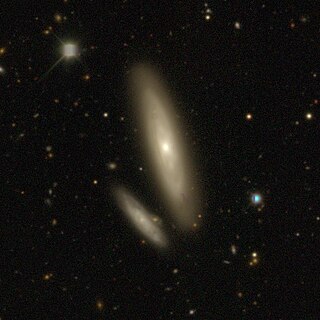
NGC 527, also occasionally referred to as PGC 5128 or PGC 5141, is a lenticular galaxy located approximately 259 million light-years from the Solar System in the constellation Sculptor. It was discovered on 1 September 1834 by astronomer John Herschel.

NGC 3048 is a pair of spiral galaxies located in the constellation Leo. It was discovered on April 27, 1864, by German astronomer Albert Marth. The object consists of a visual pair of galaxies, PGC 1509261 and PGC 28595. PGC 1509261 is likely a physical pair with a much fainter galactic object not a part of the New General Catalogue, J095458+162726.

NGC 5523 is an unbarred spiral galaxy in the constellation of Boötes, registered in New General Catalogue (NGC). The galaxy forms an equilateral triangle with NGC 5641 and NGC 5466 when observed using a telescope from the ground.

NGC 5641 is a type Sb-barred spiral galaxy in the constellation of Boötes, registered in New General Catalogue (NGC). It is located five degrees east of NGC 5466.
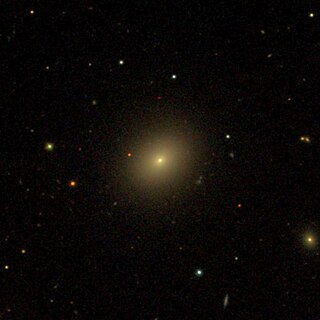
NGC 5500 is an elliptical galaxy in the constellation of Boötes, registered in New General Catalogue (NGC).
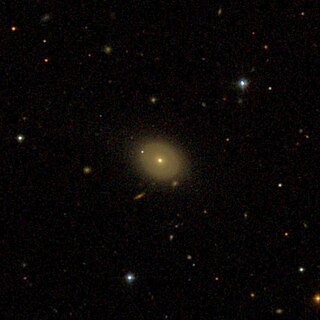
NGC 5501 is an unbarred spiral galaxy in the constellation of Virgo, registered in New General Catalogue (NGC).




















